International HRM Practice: Challenges, Strategies, and Motivation
VerifiedAdded on 2020/05/04
|12
|3136
|83
Report
AI Summary
This report delves into Microsoft's international HRM practices, examining the challenges the company faces in global expansion, particularly in markets like Africa and Britain. It outlines specific strategies for these regions, including low-budget product offerings and targeting areas with high connectivity in Africa, and emphasizing quality, innovation, and demand diversity in Britain. The report analyzes the benefits and limitations of these strategies. Furthermore, it applies Hofstede's cultural dimensions model to understand cultural differences and their impact on employee motivation. The report concludes with recommendations for motivating expatriate employees through incentives, training, vacation trips, insurance plans, and promotions, crucial for successful international operations.
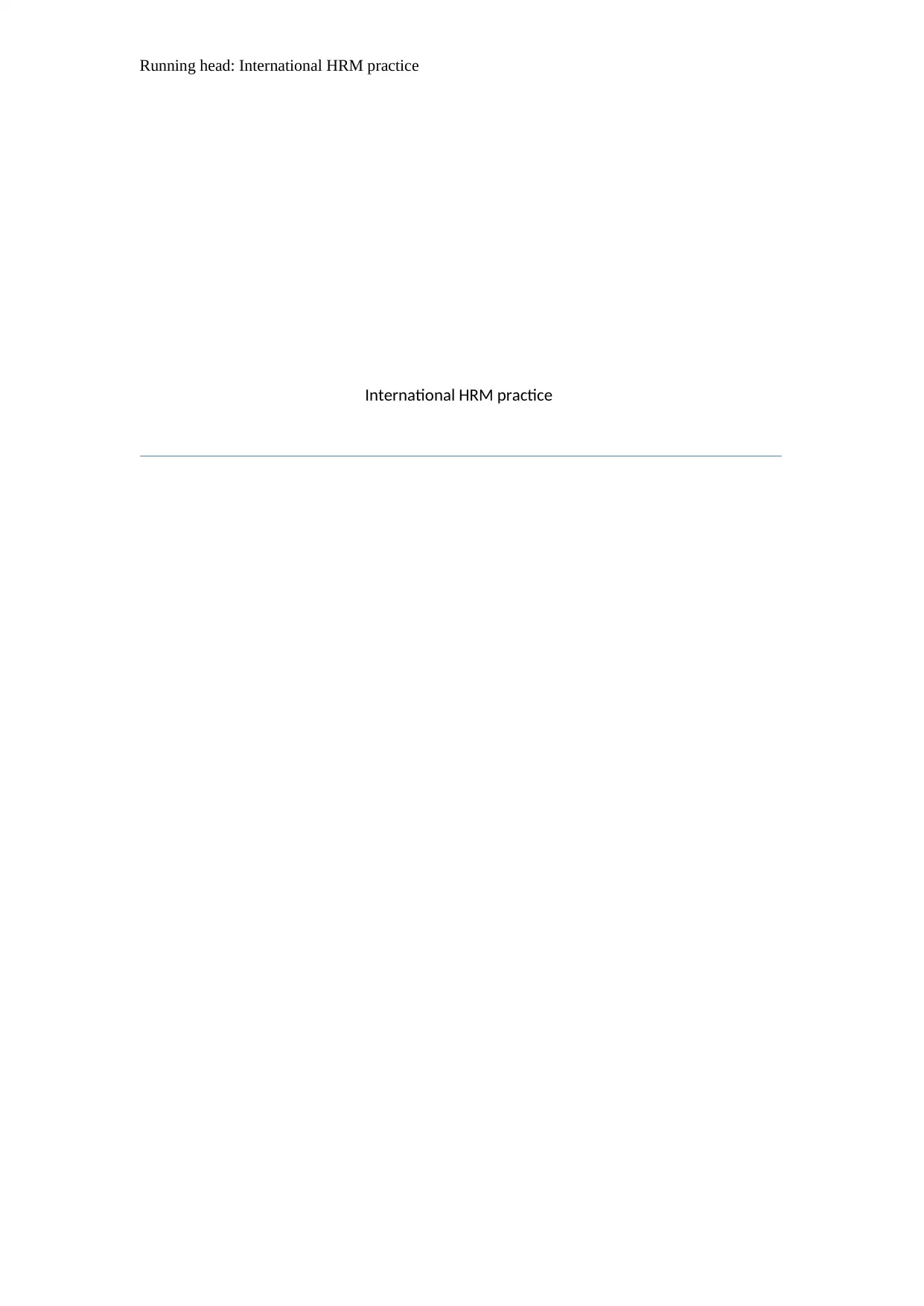
Running head: International HRM practice
International HRM practice
International HRM practice
Paraphrase This Document
Need a fresh take? Get an instant paraphrase of this document with our AI Paraphraser
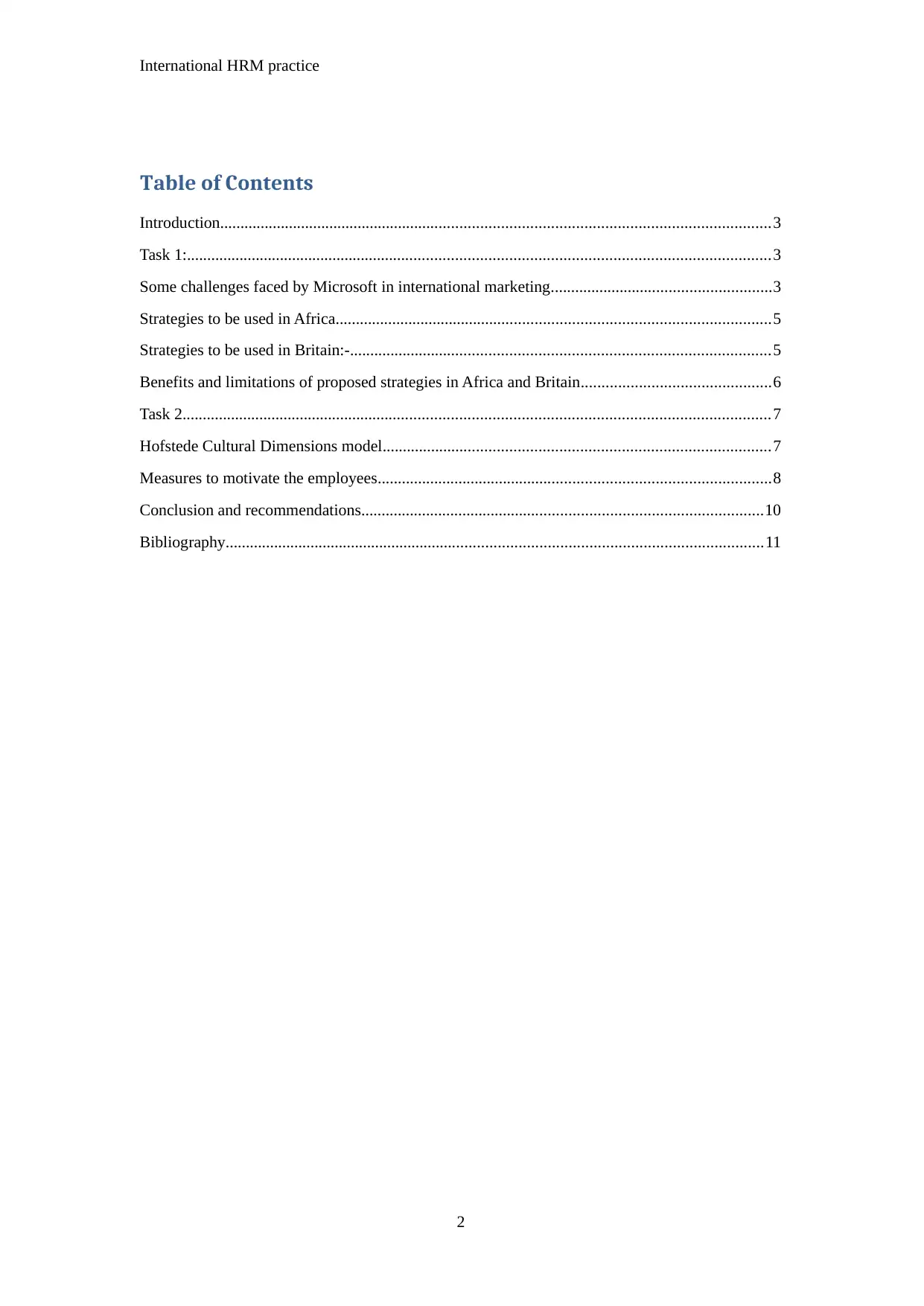
International HRM practice
Table of Contents
Introduction......................................................................................................................................3
Task 1:..............................................................................................................................................3
Some challenges faced by Microsoft in international marketing......................................................3
Strategies to be used in Africa..........................................................................................................5
Strategies to be used in Britain:-......................................................................................................5
Benefits and limitations of proposed strategies in Africa and Britain..............................................6
Task 2...............................................................................................................................................7
Hofstede Cultural Dimensions model..............................................................................................7
Measures to motivate the employees................................................................................................8
Conclusion and recommendations..................................................................................................10
Bibliography...................................................................................................................................11
2
Table of Contents
Introduction......................................................................................................................................3
Task 1:..............................................................................................................................................3
Some challenges faced by Microsoft in international marketing......................................................3
Strategies to be used in Africa..........................................................................................................5
Strategies to be used in Britain:-......................................................................................................5
Benefits and limitations of proposed strategies in Africa and Britain..............................................6
Task 2...............................................................................................................................................7
Hofstede Cultural Dimensions model..............................................................................................7
Measures to motivate the employees................................................................................................8
Conclusion and recommendations..................................................................................................10
Bibliography...................................................................................................................................11
2
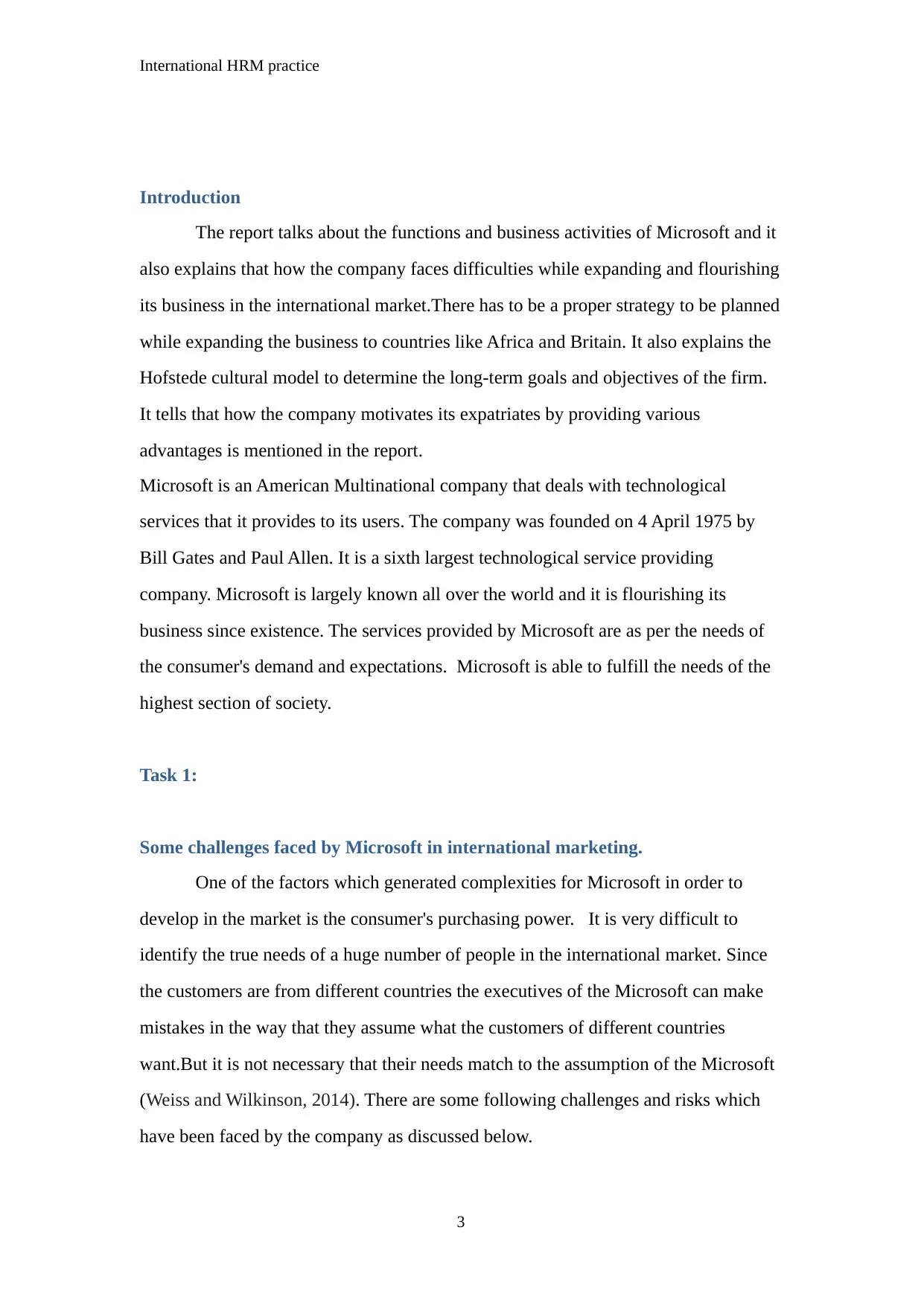
International HRM practice
Introduction
The report talks about the functions and business activities of Microsoft and it
also explains that how the company faces difficulties while expanding and flourishing
its business in the international market.There has to be a proper strategy to be planned
while expanding the business to countries like Africa and Britain. It also explains the
Hofstede cultural model to determine the long-term goals and objectives of the firm.
It tells that how the company motivates its expatriates by providing various
advantages is mentioned in the report.
Microsoft is an American Multinational company that deals with technological
services that it provides to its users. The company was founded on 4 April 1975 by
Bill Gates and Paul Allen. It is a sixth largest technological service providing
company. Microsoft is largely known all over the world and it is flourishing its
business since existence. The services provided by Microsoft are as per the needs of
the consumer's demand and expectations. Microsoft is able to fulfill the needs of the
highest section of society.
Task 1:
Some challenges faced by Microsoft in international marketing.
One of the factors which generated complexities for Microsoft in order to
develop in the market is the consumer's purchasing power. It is very difficult to
identify the true needs of a huge number of people in the international market. Since
the customers are from different countries the executives of the Microsoft can make
mistakes in the way that they assume what the customers of different countries
want.But it is not necessary that their needs match to the assumption of the Microsoft
(Weiss and Wilkinson, 2014). There are some following challenges and risks which
have been faced by the company as discussed below.
3
Introduction
The report talks about the functions and business activities of Microsoft and it
also explains that how the company faces difficulties while expanding and flourishing
its business in the international market.There has to be a proper strategy to be planned
while expanding the business to countries like Africa and Britain. It also explains the
Hofstede cultural model to determine the long-term goals and objectives of the firm.
It tells that how the company motivates its expatriates by providing various
advantages is mentioned in the report.
Microsoft is an American Multinational company that deals with technological
services that it provides to its users. The company was founded on 4 April 1975 by
Bill Gates and Paul Allen. It is a sixth largest technological service providing
company. Microsoft is largely known all over the world and it is flourishing its
business since existence. The services provided by Microsoft are as per the needs of
the consumer's demand and expectations. Microsoft is able to fulfill the needs of the
highest section of society.
Task 1:
Some challenges faced by Microsoft in international marketing.
One of the factors which generated complexities for Microsoft in order to
develop in the market is the consumer's purchasing power. It is very difficult to
identify the true needs of a huge number of people in the international market. Since
the customers are from different countries the executives of the Microsoft can make
mistakes in the way that they assume what the customers of different countries
want.But it is not necessary that their needs match to the assumption of the Microsoft
(Weiss and Wilkinson, 2014). There are some following challenges and risks which
have been faced by the company as discussed below.
3
⊘ This is a preview!⊘
Do you want full access?
Subscribe today to unlock all pages.

Trusted by 1+ million students worldwide
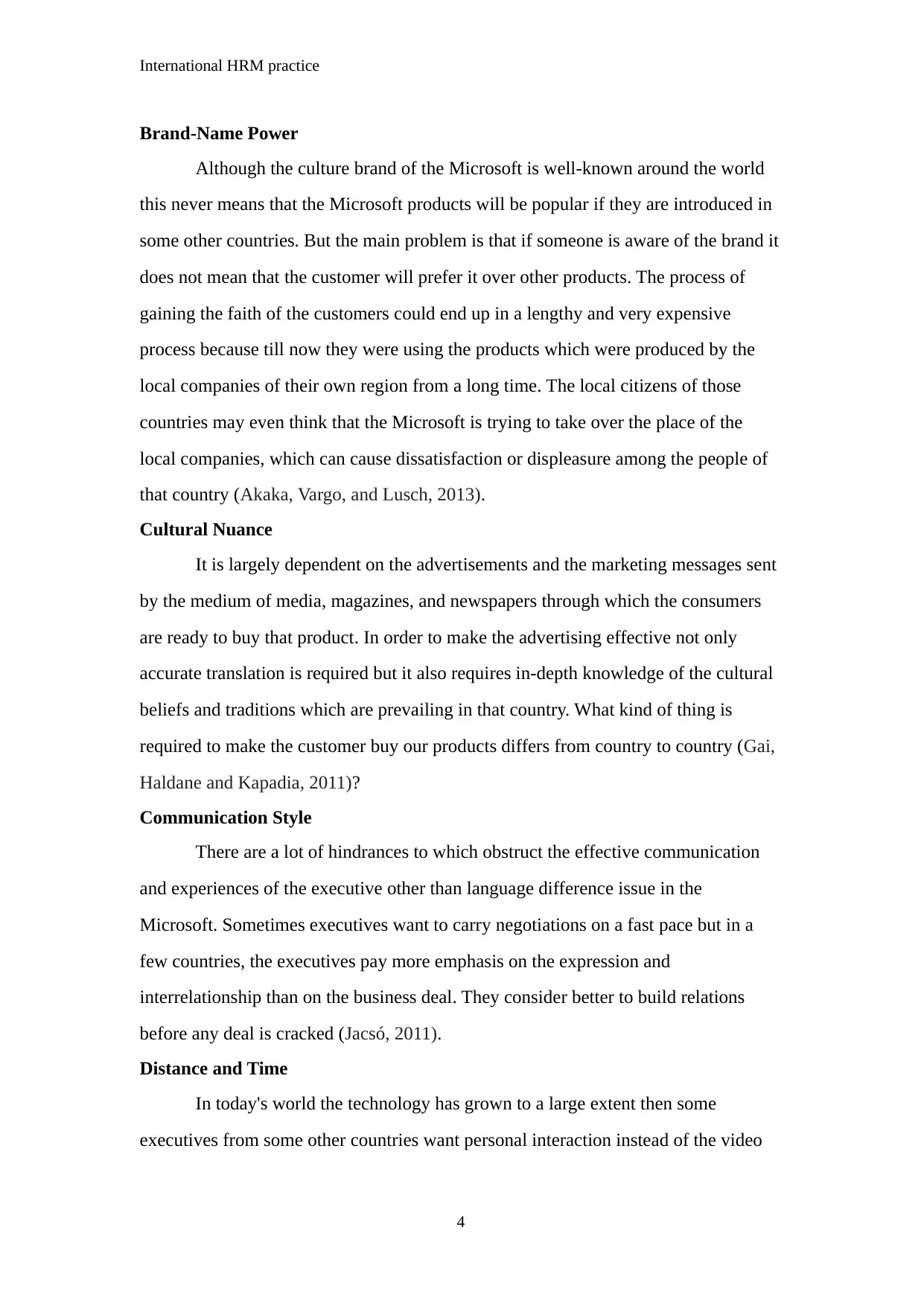
International HRM practice
Brand-Name Power
Although the culture brand of the Microsoft is well-known around the world
this never means that the Microsoft products will be popular if they are introduced in
some other countries. But the main problem is that if someone is aware of the brand it
does not mean that the customer will prefer it over other products. The process of
gaining the faith of the customers could end up in a lengthy and very expensive
process because till now they were using the products which were produced by the
local companies of their own region from a long time. The local citizens of those
countries may even think that the Microsoft is trying to take over the place of the
local companies, which can cause dissatisfaction or displeasure among the people of
that country (Akaka, Vargo, and Lusch, 2013).
Cultural Nuance
It is largely dependent on the advertisements and the marketing messages sent
by the medium of media, magazines, and newspapers through which the consumers
are ready to buy that product. In order to make the advertising effective not only
accurate translation is required but it also requires in-depth knowledge of the cultural
beliefs and traditions which are prevailing in that country. What kind of thing is
required to make the customer buy our products differs from country to country (Gai,
Haldane and Kapadia, 2011)?
Communication Style
There are a lot of hindrances to which obstruct the effective communication
and experiences of the executive other than language difference issue in the
Microsoft. Sometimes executives want to carry negotiations on a fast pace but in a
few countries, the executives pay more emphasis on the expression and
interrelationship than on the business deal. They consider better to build relations
before any deal is cracked (Jacsó, 2011).
Distance and Time
In today's world the technology has grown to a large extent then some
executives from some other countries want personal interaction instead of the video
4
Brand-Name Power
Although the culture brand of the Microsoft is well-known around the world
this never means that the Microsoft products will be popular if they are introduced in
some other countries. But the main problem is that if someone is aware of the brand it
does not mean that the customer will prefer it over other products. The process of
gaining the faith of the customers could end up in a lengthy and very expensive
process because till now they were using the products which were produced by the
local companies of their own region from a long time. The local citizens of those
countries may even think that the Microsoft is trying to take over the place of the
local companies, which can cause dissatisfaction or displeasure among the people of
that country (Akaka, Vargo, and Lusch, 2013).
Cultural Nuance
It is largely dependent on the advertisements and the marketing messages sent
by the medium of media, magazines, and newspapers through which the consumers
are ready to buy that product. In order to make the advertising effective not only
accurate translation is required but it also requires in-depth knowledge of the cultural
beliefs and traditions which are prevailing in that country. What kind of thing is
required to make the customer buy our products differs from country to country (Gai,
Haldane and Kapadia, 2011)?
Communication Style
There are a lot of hindrances to which obstruct the effective communication
and experiences of the executive other than language difference issue in the
Microsoft. Sometimes executives want to carry negotiations on a fast pace but in a
few countries, the executives pay more emphasis on the expression and
interrelationship than on the business deal. They consider better to build relations
before any deal is cracked (Jacsó, 2011).
Distance and Time
In today's world the technology has grown to a large extent then some
executives from some other countries want personal interaction instead of the video
4
Paraphrase This Document
Need a fresh take? Get an instant paraphrase of this document with our AI Paraphraser
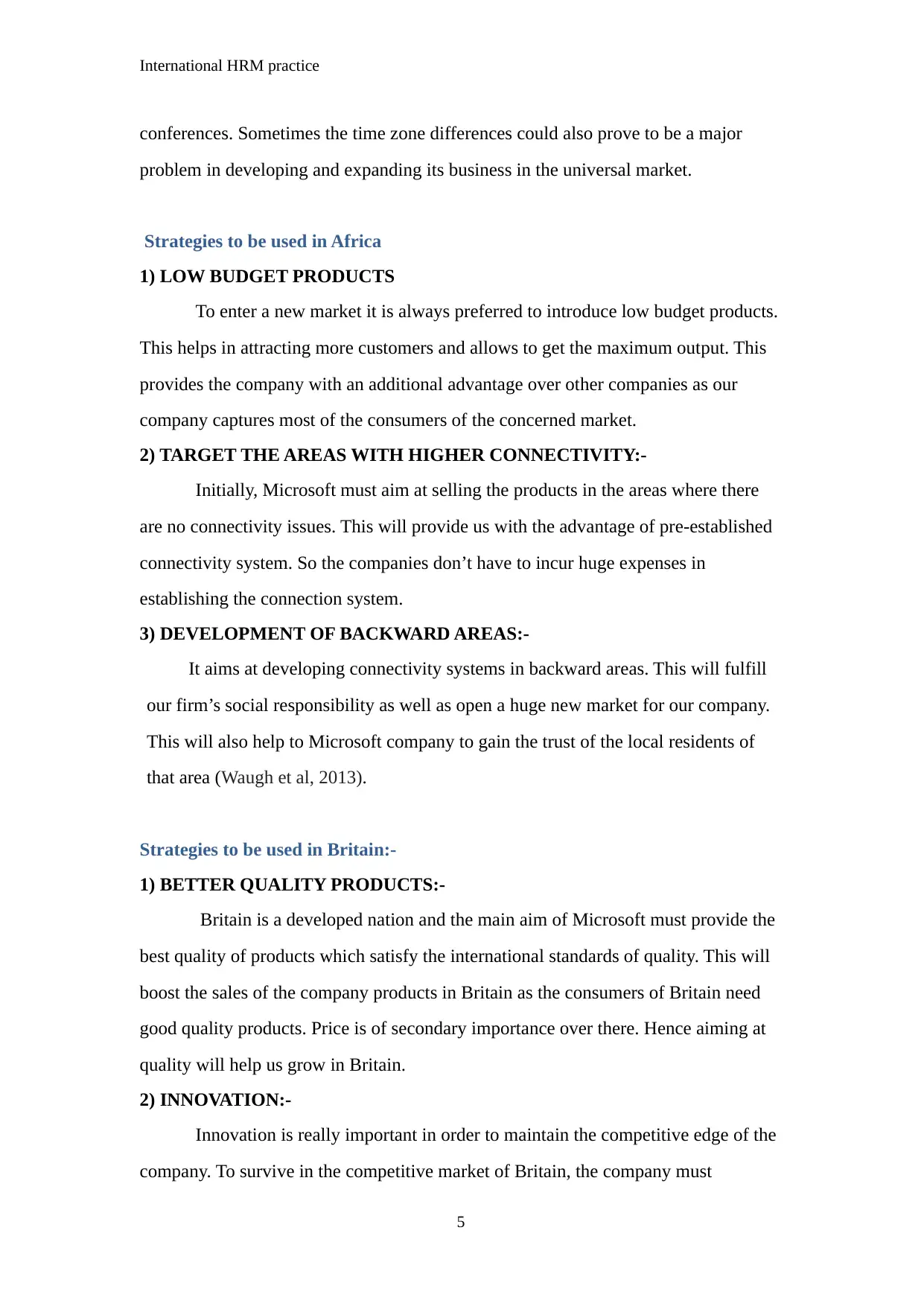
International HRM practice
conferences. Sometimes the time zone differences could also prove to be a major
problem in developing and expanding its business in the universal market.
Strategies to be used in Africa
1) LOW BUDGET PRODUCTS
To enter a new market it is always preferred to introduce low budget products.
This helps in attracting more customers and allows to get the maximum output. This
provides the company with an additional advantage over other companies as our
company captures most of the consumers of the concerned market.
2) TARGET THE AREAS WITH HIGHER CONNECTIVITY:-
Initially, Microsoft must aim at selling the products in the areas where there
are no connectivity issues. This will provide us with the advantage of pre-established
connectivity system. So the companies don’t have to incur huge expenses in
establishing the connection system.
3) DEVELOPMENT OF BACKWARD AREAS:-
It aims at developing connectivity systems in backward areas. This will fulfill
our firm’s social responsibility as well as open a huge new market for our company.
This will also help to Microsoft company to gain the trust of the local residents of
that area (Waugh et al, 2013).
Strategies to be used in Britain:-
1) BETTER QUALITY PRODUCTS:-
Britain is a developed nation and the main aim of Microsoft must provide the
best quality of products which satisfy the international standards of quality. This will
boost the sales of the company products in Britain as the consumers of Britain need
good quality products. Price is of secondary importance over there. Hence aiming at
quality will help us grow in Britain.
2) INNOVATION:-
Innovation is really important in order to maintain the competitive edge of the
company. To survive in the competitive market of Britain, the company must
5
conferences. Sometimes the time zone differences could also prove to be a major
problem in developing and expanding its business in the universal market.
Strategies to be used in Africa
1) LOW BUDGET PRODUCTS
To enter a new market it is always preferred to introduce low budget products.
This helps in attracting more customers and allows to get the maximum output. This
provides the company with an additional advantage over other companies as our
company captures most of the consumers of the concerned market.
2) TARGET THE AREAS WITH HIGHER CONNECTIVITY:-
Initially, Microsoft must aim at selling the products in the areas where there
are no connectivity issues. This will provide us with the advantage of pre-established
connectivity system. So the companies don’t have to incur huge expenses in
establishing the connection system.
3) DEVELOPMENT OF BACKWARD AREAS:-
It aims at developing connectivity systems in backward areas. This will fulfill
our firm’s social responsibility as well as open a huge new market for our company.
This will also help to Microsoft company to gain the trust of the local residents of
that area (Waugh et al, 2013).
Strategies to be used in Britain:-
1) BETTER QUALITY PRODUCTS:-
Britain is a developed nation and the main aim of Microsoft must provide the
best quality of products which satisfy the international standards of quality. This will
boost the sales of the company products in Britain as the consumers of Britain need
good quality products. Price is of secondary importance over there. Hence aiming at
quality will help us grow in Britain.
2) INNOVATION:-
Innovation is really important in order to maintain the competitive edge of the
company. To survive in the competitive market of Britain, the company must
5
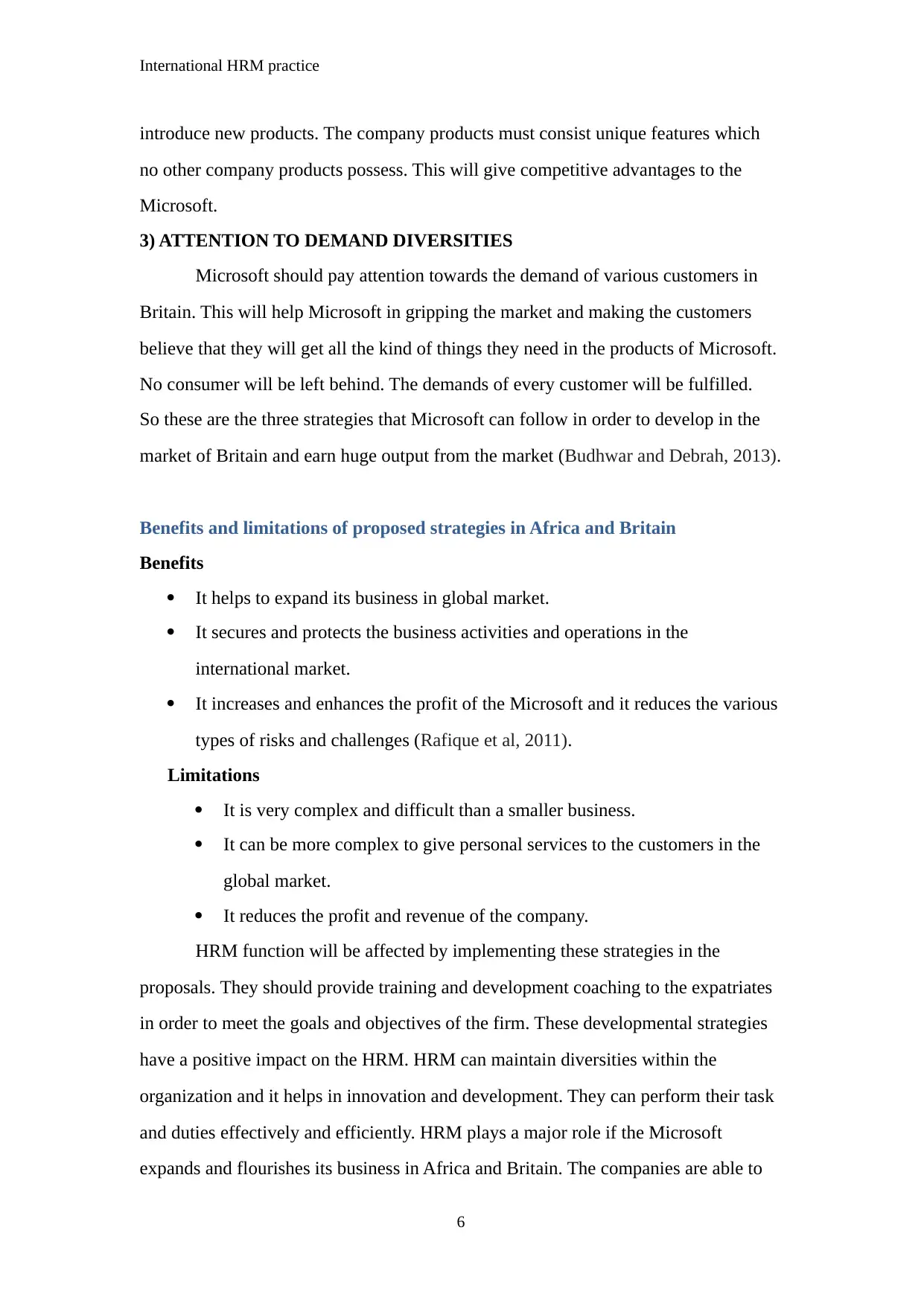
International HRM practice
introduce new products. The company products must consist unique features which
no other company products possess. This will give competitive advantages to the
Microsoft.
3) ATTENTION TO DEMAND DIVERSITIES
Microsoft should pay attention towards the demand of various customers in
Britain. This will help Microsoft in gripping the market and making the customers
believe that they will get all the kind of things they need in the products of Microsoft.
No consumer will be left behind. The demands of every customer will be fulfilled.
So these are the three strategies that Microsoft can follow in order to develop in the
market of Britain and earn huge output from the market (Budhwar and Debrah, 2013).
Benefits and limitations of proposed strategies in Africa and Britain
Benefits
It helps to expand its business in global market.
It secures and protects the business activities and operations in the
international market.
It increases and enhances the profit of the Microsoft and it reduces the various
types of risks and challenges (Rafique et al, 2011).
Limitations
It is very complex and difficult than a smaller business.
It can be more complex to give personal services to the customers in the
global market.
It reduces the profit and revenue of the company.
HRM function will be affected by implementing these strategies in the
proposals. They should provide training and development coaching to the expatriates
in order to meet the goals and objectives of the firm. These developmental strategies
have a positive impact on the HRM. HRM can maintain diversities within the
organization and it helps in innovation and development. They can perform their task
and duties effectively and efficiently. HRM plays a major role if the Microsoft
expands and flourishes its business in Africa and Britain. The companies are able to
6
introduce new products. The company products must consist unique features which
no other company products possess. This will give competitive advantages to the
Microsoft.
3) ATTENTION TO DEMAND DIVERSITIES
Microsoft should pay attention towards the demand of various customers in
Britain. This will help Microsoft in gripping the market and making the customers
believe that they will get all the kind of things they need in the products of Microsoft.
No consumer will be left behind. The demands of every customer will be fulfilled.
So these are the three strategies that Microsoft can follow in order to develop in the
market of Britain and earn huge output from the market (Budhwar and Debrah, 2013).
Benefits and limitations of proposed strategies in Africa and Britain
Benefits
It helps to expand its business in global market.
It secures and protects the business activities and operations in the
international market.
It increases and enhances the profit of the Microsoft and it reduces the various
types of risks and challenges (Rafique et al, 2011).
Limitations
It is very complex and difficult than a smaller business.
It can be more complex to give personal services to the customers in the
global market.
It reduces the profit and revenue of the company.
HRM function will be affected by implementing these strategies in the
proposals. They should provide training and development coaching to the expatriates
in order to meet the goals and objectives of the firm. These developmental strategies
have a positive impact on the HRM. HRM can maintain diversities within the
organization and it helps in innovation and development. They can perform their task
and duties effectively and efficiently. HRM plays a major role if the Microsoft
expands and flourishes its business in Africa and Britain. The companies are able to
6
⊘ This is a preview!⊘
Do you want full access?
Subscribe today to unlock all pages.

Trusted by 1+ million students worldwide
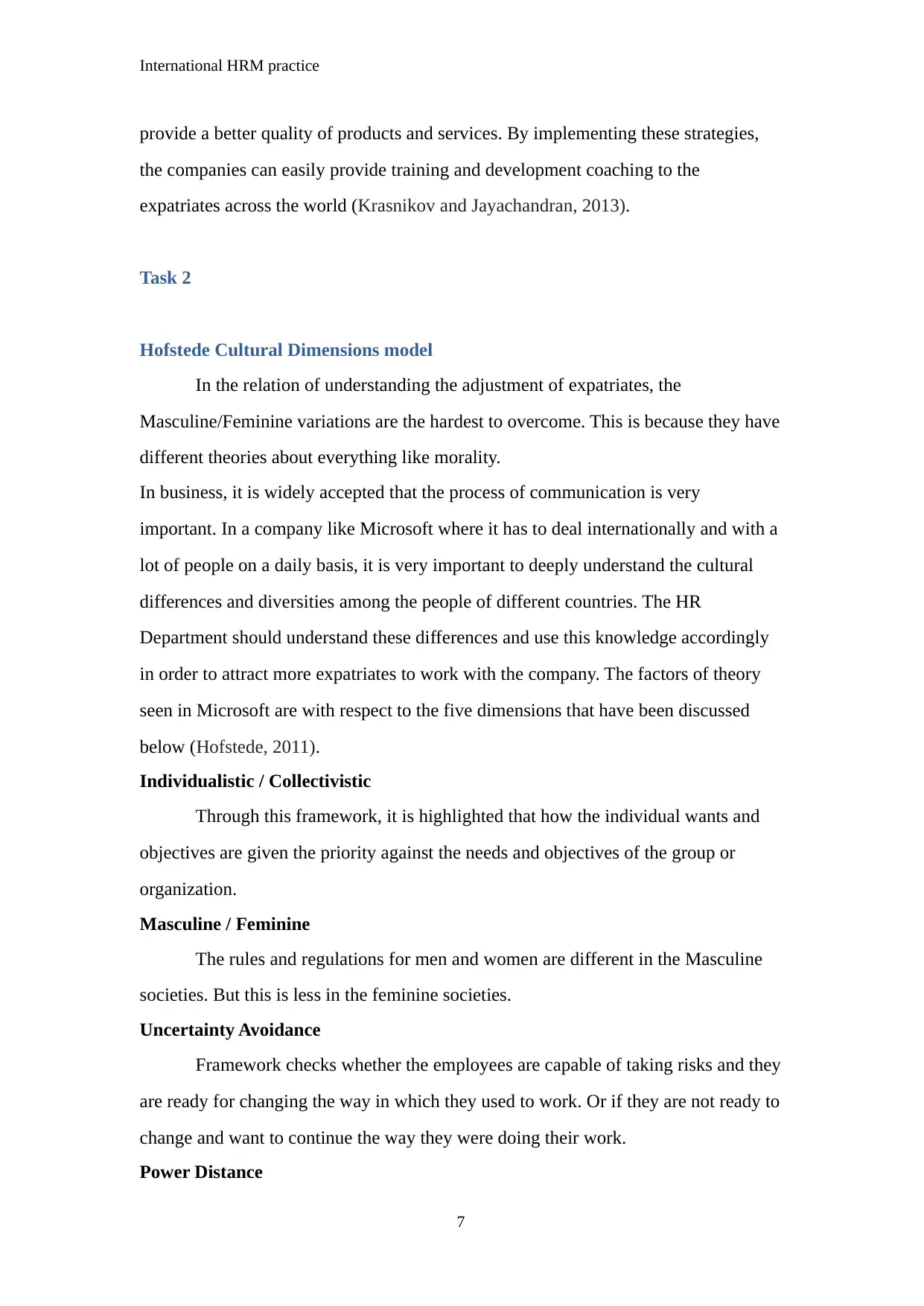
International HRM practice
provide a better quality of products and services. By implementing these strategies,
the companies can easily provide training and development coaching to the
expatriates across the world (Krasnikov and Jayachandran, 2013).
Task 2
Hofstede Cultural Dimensions model
In the relation of understanding the adjustment of expatriates, the
Masculine/Feminine variations are the hardest to overcome. This is because they have
different theories about everything like morality.
In business, it is widely accepted that the process of communication is very
important. In a company like Microsoft where it has to deal internationally and with a
lot of people on a daily basis, it is very important to deeply understand the cultural
differences and diversities among the people of different countries. The HR
Department should understand these differences and use this knowledge accordingly
in order to attract more expatriates to work with the company. The factors of theory
seen in Microsoft are with respect to the five dimensions that have been discussed
below (Hofstede, 2011).
Individualistic / Collectivistic
Through this framework, it is highlighted that how the individual wants and
objectives are given the priority against the needs and objectives of the group or
organization.
Masculine / Feminine
The rules and regulations for men and women are different in the Masculine
societies. But this is less in the feminine societies.
Uncertainty Avoidance
Framework checks whether the employees are capable of taking risks and they
are ready for changing the way in which they used to work. Or if they are not ready to
change and want to continue the way they were doing their work.
Power Distance
7
provide a better quality of products and services. By implementing these strategies,
the companies can easily provide training and development coaching to the
expatriates across the world (Krasnikov and Jayachandran, 2013).
Task 2
Hofstede Cultural Dimensions model
In the relation of understanding the adjustment of expatriates, the
Masculine/Feminine variations are the hardest to overcome. This is because they have
different theories about everything like morality.
In business, it is widely accepted that the process of communication is very
important. In a company like Microsoft where it has to deal internationally and with a
lot of people on a daily basis, it is very important to deeply understand the cultural
differences and diversities among the people of different countries. The HR
Department should understand these differences and use this knowledge accordingly
in order to attract more expatriates to work with the company. The factors of theory
seen in Microsoft are with respect to the five dimensions that have been discussed
below (Hofstede, 2011).
Individualistic / Collectivistic
Through this framework, it is highlighted that how the individual wants and
objectives are given the priority against the needs and objectives of the group or
organization.
Masculine / Feminine
The rules and regulations for men and women are different in the Masculine
societies. But this is less in the feminine societies.
Uncertainty Avoidance
Framework checks whether the employees are capable of taking risks and they
are ready for changing the way in which they used to work. Or if they are not ready to
change and want to continue the way they were doing their work.
Power Distance
7
Paraphrase This Document
Need a fresh take? Get an instant paraphrase of this document with our AI Paraphraser
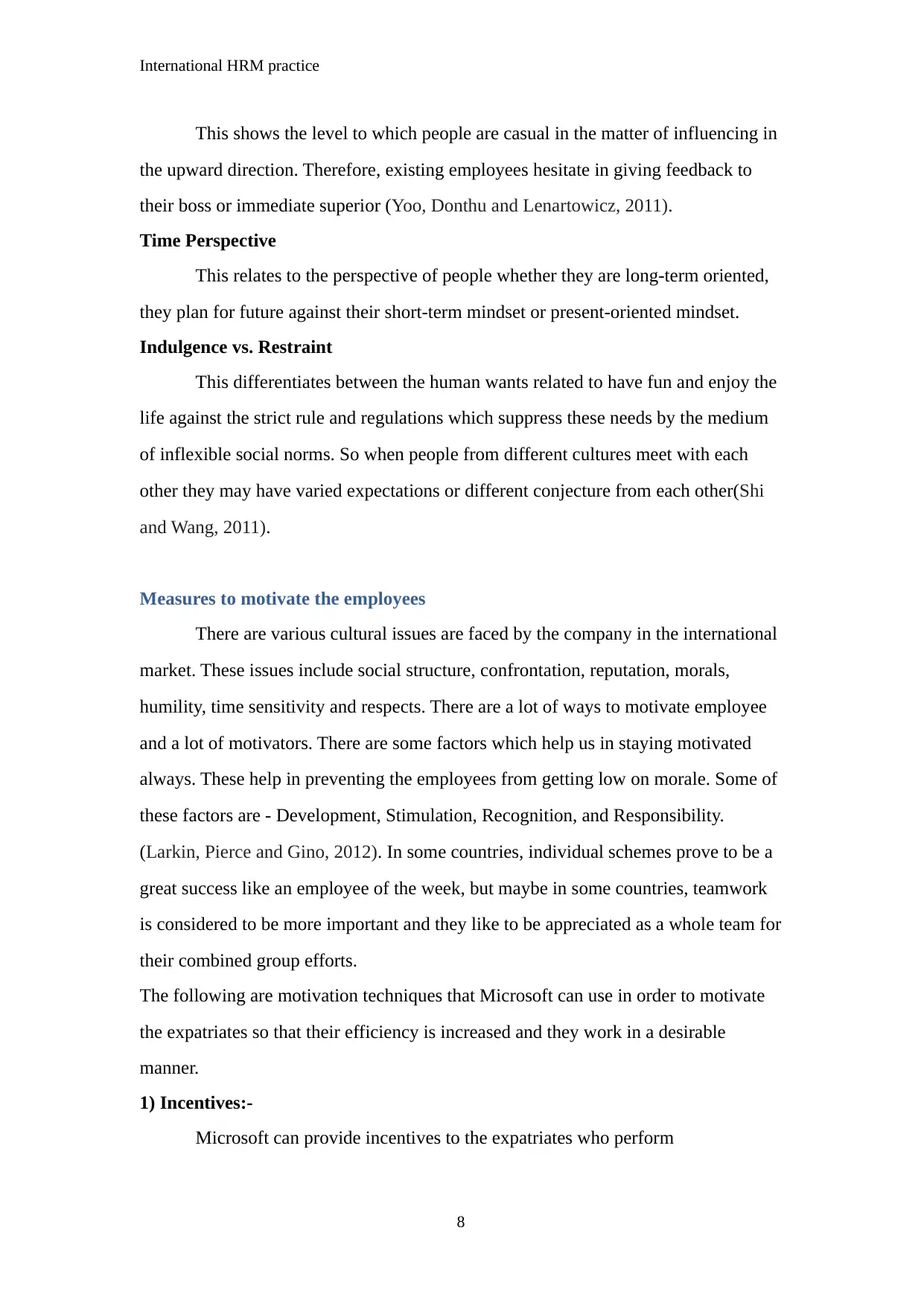
International HRM practice
This shows the level to which people are casual in the matter of influencing in
the upward direction. Therefore, existing employees hesitate in giving feedback to
their boss or immediate superior (Yoo, Donthu and Lenartowicz, 2011).
Time Perspective
This relates to the perspective of people whether they are long-term oriented,
they plan for future against their short-term mindset or present-oriented mindset.
Indulgence vs. Restraint
This differentiates between the human wants related to have fun and enjoy the
life against the strict rule and regulations which suppress these needs by the medium
of inflexible social norms. So when people from different cultures meet with each
other they may have varied expectations or different conjecture from each other(Shi
and Wang, 2011).
Measures to motivate the employees
There are various cultural issues are faced by the company in the international
market. These issues include social structure, confrontation, reputation, morals,
humility, time sensitivity and respects. There are a lot of ways to motivate employee
and a lot of motivators. There are some factors which help us in staying motivated
always. These help in preventing the employees from getting low on morale. Some of
these factors are - Development, Stimulation, Recognition, and Responsibility.
(Larkin, Pierce and Gino, 2012). In some countries, individual schemes prove to be a
great success like an employee of the week, but maybe in some countries, teamwork
is considered to be more important and they like to be appreciated as a whole team for
their combined group efforts.
The following are motivation techniques that Microsoft can use in order to motivate
the expatriates so that their efficiency is increased and they work in a desirable
manner.
1) Incentives:-
Microsoft can provide incentives to the expatriates who perform
8
This shows the level to which people are casual in the matter of influencing in
the upward direction. Therefore, existing employees hesitate in giving feedback to
their boss or immediate superior (Yoo, Donthu and Lenartowicz, 2011).
Time Perspective
This relates to the perspective of people whether they are long-term oriented,
they plan for future against their short-term mindset or present-oriented mindset.
Indulgence vs. Restraint
This differentiates between the human wants related to have fun and enjoy the
life against the strict rule and regulations which suppress these needs by the medium
of inflexible social norms. So when people from different cultures meet with each
other they may have varied expectations or different conjecture from each other(Shi
and Wang, 2011).
Measures to motivate the employees
There are various cultural issues are faced by the company in the international
market. These issues include social structure, confrontation, reputation, morals,
humility, time sensitivity and respects. There are a lot of ways to motivate employee
and a lot of motivators. There are some factors which help us in staying motivated
always. These help in preventing the employees from getting low on morale. Some of
these factors are - Development, Stimulation, Recognition, and Responsibility.
(Larkin, Pierce and Gino, 2012). In some countries, individual schemes prove to be a
great success like an employee of the week, but maybe in some countries, teamwork
is considered to be more important and they like to be appreciated as a whole team for
their combined group efforts.
The following are motivation techniques that Microsoft can use in order to motivate
the expatriates so that their efficiency is increased and they work in a desirable
manner.
1) Incentives:-
Microsoft can provide incentives to the expatriates who perform
8
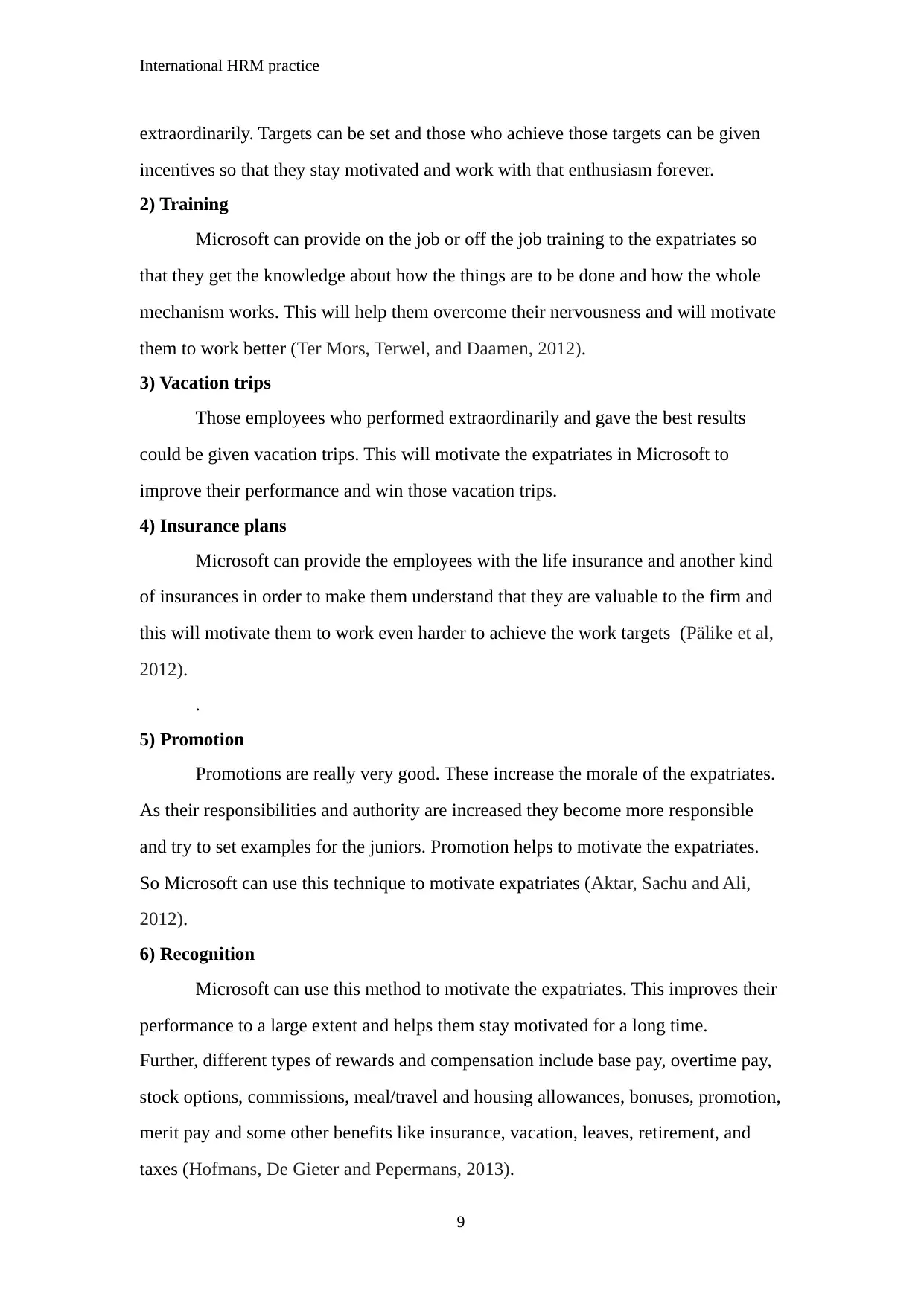
International HRM practice
extraordinarily. Targets can be set and those who achieve those targets can be given
incentives so that they stay motivated and work with that enthusiasm forever.
2) Training
Microsoft can provide on the job or off the job training to the expatriates so
that they get the knowledge about how the things are to be done and how the whole
mechanism works. This will help them overcome their nervousness and will motivate
them to work better (Ter Mors, Terwel, and Daamen, 2012).
3) Vacation trips
Those employees who performed extraordinarily and gave the best results
could be given vacation trips. This will motivate the expatriates in Microsoft to
improve their performance and win those vacation trips.
4) Insurance plans
Microsoft can provide the employees with the life insurance and another kind
of insurances in order to make them understand that they are valuable to the firm and
this will motivate them to work even harder to achieve the work targets (Pälike et al,
2012).
.
5) Promotion
Promotions are really very good. These increase the morale of the expatriates.
As their responsibilities and authority are increased they become more responsible
and try to set examples for the juniors. Promotion helps to motivate the expatriates.
So Microsoft can use this technique to motivate expatriates (Aktar, Sachu and Ali,
2012).
6) Recognition
Microsoft can use this method to motivate the expatriates. This improves their
performance to a large extent and helps them stay motivated for a long time.
Further, different types of rewards and compensation include base pay, overtime pay,
stock options, commissions, meal/travel and housing allowances, bonuses, promotion,
merit pay and some other benefits like insurance, vacation, leaves, retirement, and
taxes (Hofmans, De Gieter and Pepermans, 2013).
9
extraordinarily. Targets can be set and those who achieve those targets can be given
incentives so that they stay motivated and work with that enthusiasm forever.
2) Training
Microsoft can provide on the job or off the job training to the expatriates so
that they get the knowledge about how the things are to be done and how the whole
mechanism works. This will help them overcome their nervousness and will motivate
them to work better (Ter Mors, Terwel, and Daamen, 2012).
3) Vacation trips
Those employees who performed extraordinarily and gave the best results
could be given vacation trips. This will motivate the expatriates in Microsoft to
improve their performance and win those vacation trips.
4) Insurance plans
Microsoft can provide the employees with the life insurance and another kind
of insurances in order to make them understand that they are valuable to the firm and
this will motivate them to work even harder to achieve the work targets (Pälike et al,
2012).
.
5) Promotion
Promotions are really very good. These increase the morale of the expatriates.
As their responsibilities and authority are increased they become more responsible
and try to set examples for the juniors. Promotion helps to motivate the expatriates.
So Microsoft can use this technique to motivate expatriates (Aktar, Sachu and Ali,
2012).
6) Recognition
Microsoft can use this method to motivate the expatriates. This improves their
performance to a large extent and helps them stay motivated for a long time.
Further, different types of rewards and compensation include base pay, overtime pay,
stock options, commissions, meal/travel and housing allowances, bonuses, promotion,
merit pay and some other benefits like insurance, vacation, leaves, retirement, and
taxes (Hofmans, De Gieter and Pepermans, 2013).
9
⊘ This is a preview!⊘
Do you want full access?
Subscribe today to unlock all pages.

Trusted by 1+ million students worldwide
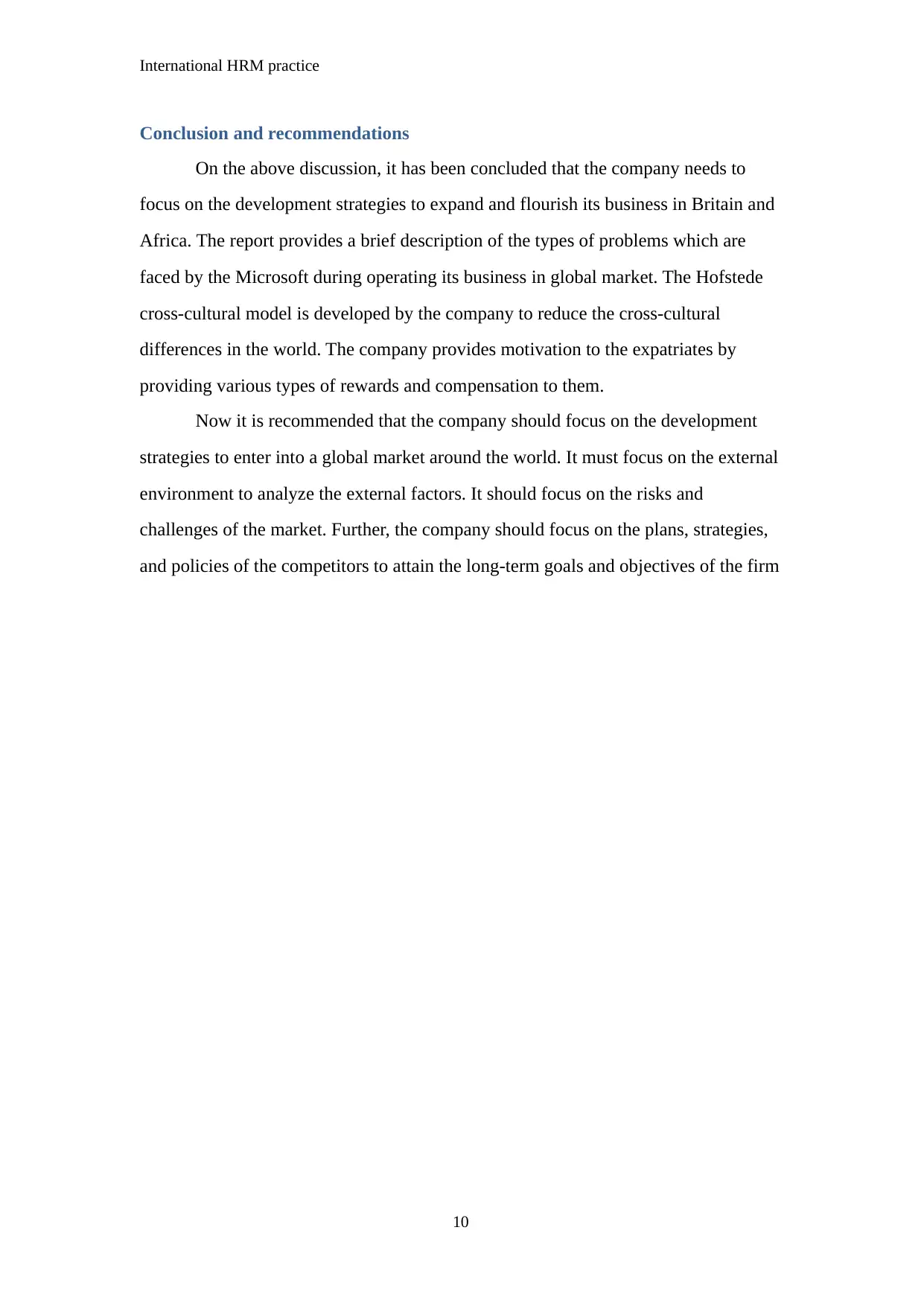
International HRM practice
Conclusion and recommendations
On the above discussion, it has been concluded that the company needs to
focus on the development strategies to expand and flourish its business in Britain and
Africa. The report provides a brief description of the types of problems which are
faced by the Microsoft during operating its business in global market. The Hofstede
cross-cultural model is developed by the company to reduce the cross-cultural
differences in the world. The company provides motivation to the expatriates by
providing various types of rewards and compensation to them.
Now it is recommended that the company should focus on the development
strategies to enter into a global market around the world. It must focus on the external
environment to analyze the external factors. It should focus on the risks and
challenges of the market. Further, the company should focus on the plans, strategies,
and policies of the competitors to attain the long-term goals and objectives of the firm
10
Conclusion and recommendations
On the above discussion, it has been concluded that the company needs to
focus on the development strategies to expand and flourish its business in Britain and
Africa. The report provides a brief description of the types of problems which are
faced by the Microsoft during operating its business in global market. The Hofstede
cross-cultural model is developed by the company to reduce the cross-cultural
differences in the world. The company provides motivation to the expatriates by
providing various types of rewards and compensation to them.
Now it is recommended that the company should focus on the development
strategies to enter into a global market around the world. It must focus on the external
environment to analyze the external factors. It should focus on the risks and
challenges of the market. Further, the company should focus on the plans, strategies,
and policies of the competitors to attain the long-term goals and objectives of the firm
10
Paraphrase This Document
Need a fresh take? Get an instant paraphrase of this document with our AI Paraphraser
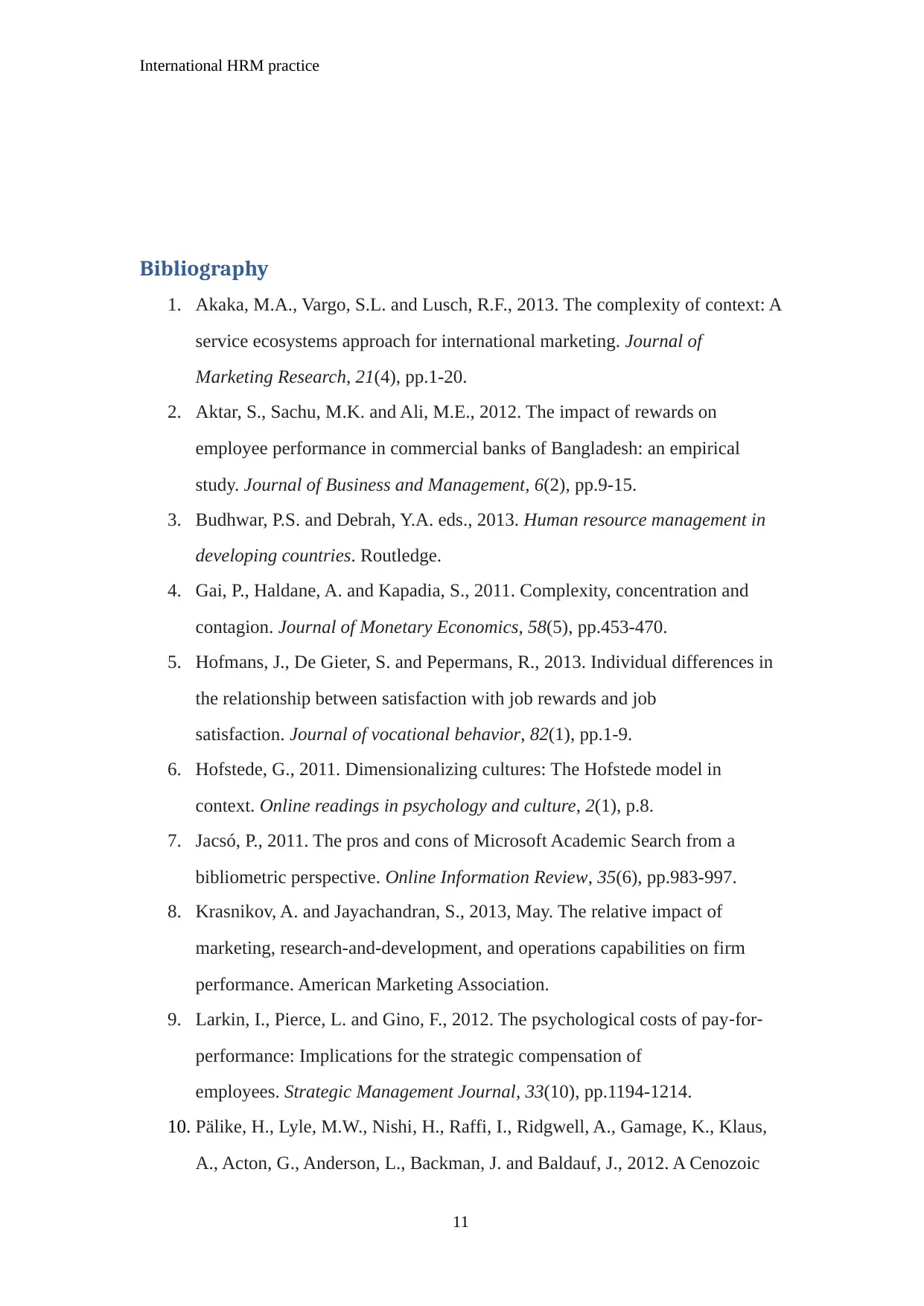
International HRM practice
Bibliography
1. Akaka, M.A., Vargo, S.L. and Lusch, R.F., 2013. The complexity of context: A
service ecosystems approach for international marketing. Journal of
Marketing Research, 21(4), pp.1-20.
2. Aktar, S., Sachu, M.K. and Ali, M.E., 2012. The impact of rewards on
employee performance in commercial banks of Bangladesh: an empirical
study. Journal of Business and Management, 6(2), pp.9-15.
3. Budhwar, P.S. and Debrah, Y.A. eds., 2013. Human resource management in
developing countries. Routledge.
4. Gai, P., Haldane, A. and Kapadia, S., 2011. Complexity, concentration and
contagion. Journal of Monetary Economics, 58(5), pp.453-470.
5. Hofmans, J., De Gieter, S. and Pepermans, R., 2013. Individual differences in
the relationship between satisfaction with job rewards and job
satisfaction. Journal of vocational behavior, 82(1), pp.1-9.
6. Hofstede, G., 2011. Dimensionalizing cultures: The Hofstede model in
context. Online readings in psychology and culture, 2(1), p.8.
7. Jacsó, P., 2011. The pros and cons of Microsoft Academic Search from a
bibliometric perspective. Online Information Review, 35(6), pp.983-997.
8. Krasnikov, A. and Jayachandran, S., 2013, May. The relative impact of
marketing, research-and-development, and operations capabilities on firm
performance. American Marketing Association.
9. Larkin, I., Pierce, L. and Gino, F., 2012. The psychological costs of pay‐for‐
performance: Implications for the strategic compensation of
employees. Strategic Management Journal, 33(10), pp.1194-1214.
10. Pälike, H., Lyle, M.W., Nishi, H., Raffi, I., Ridgwell, A., Gamage, K., Klaus,
A., Acton, G., Anderson, L., Backman, J. and Baldauf, J., 2012. A Cenozoic
11
Bibliography
1. Akaka, M.A., Vargo, S.L. and Lusch, R.F., 2013. The complexity of context: A
service ecosystems approach for international marketing. Journal of
Marketing Research, 21(4), pp.1-20.
2. Aktar, S., Sachu, M.K. and Ali, M.E., 2012. The impact of rewards on
employee performance in commercial banks of Bangladesh: an empirical
study. Journal of Business and Management, 6(2), pp.9-15.
3. Budhwar, P.S. and Debrah, Y.A. eds., 2013. Human resource management in
developing countries. Routledge.
4. Gai, P., Haldane, A. and Kapadia, S., 2011. Complexity, concentration and
contagion. Journal of Monetary Economics, 58(5), pp.453-470.
5. Hofmans, J., De Gieter, S. and Pepermans, R., 2013. Individual differences in
the relationship between satisfaction with job rewards and job
satisfaction. Journal of vocational behavior, 82(1), pp.1-9.
6. Hofstede, G., 2011. Dimensionalizing cultures: The Hofstede model in
context. Online readings in psychology and culture, 2(1), p.8.
7. Jacsó, P., 2011. The pros and cons of Microsoft Academic Search from a
bibliometric perspective. Online Information Review, 35(6), pp.983-997.
8. Krasnikov, A. and Jayachandran, S., 2013, May. The relative impact of
marketing, research-and-development, and operations capabilities on firm
performance. American Marketing Association.
9. Larkin, I., Pierce, L. and Gino, F., 2012. The psychological costs of pay‐for‐
performance: Implications for the strategic compensation of
employees. Strategic Management Journal, 33(10), pp.1194-1214.
10. Pälike, H., Lyle, M.W., Nishi, H., Raffi, I., Ridgwell, A., Gamage, K., Klaus,
A., Acton, G., Anderson, L., Backman, J. and Baldauf, J., 2012. A Cenozoic
11
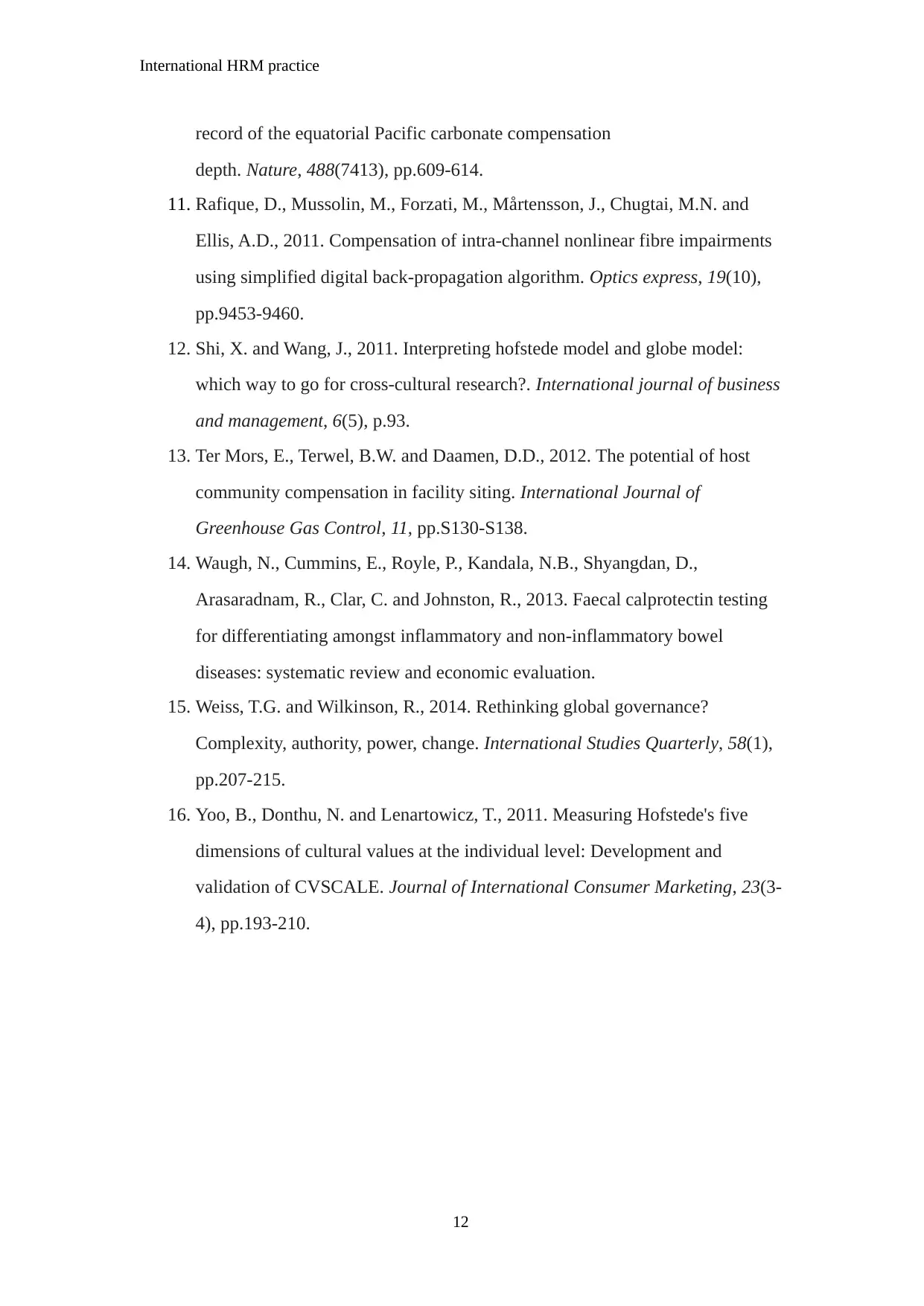
International HRM practice
record of the equatorial Pacific carbonate compensation
depth. Nature, 488(7413), pp.609-614.
11. Rafique, D., Mussolin, M., Forzati, M., Mårtensson, J., Chugtai, M.N. and
Ellis, A.D., 2011. Compensation of intra-channel nonlinear fibre impairments
using simplified digital back-propagation algorithm. Optics express, 19(10),
pp.9453-9460.
12. Shi, X. and Wang, J., 2011. Interpreting hofstede model and globe model:
which way to go for cross-cultural research?. International journal of business
and management, 6(5), p.93.
13. Ter Mors, E., Terwel, B.W. and Daamen, D.D., 2012. The potential of host
community compensation in facility siting. International Journal of
Greenhouse Gas Control, 11, pp.S130-S138.
14. Waugh, N., Cummins, E., Royle, P., Kandala, N.B., Shyangdan, D.,
Arasaradnam, R., Clar, C. and Johnston, R., 2013. Faecal calprotectin testing
for differentiating amongst inflammatory and non-inflammatory bowel
diseases: systematic review and economic evaluation.
15. Weiss, T.G. and Wilkinson, R., 2014. Rethinking global governance?
Complexity, authority, power, change. International Studies Quarterly, 58(1),
pp.207-215.
16. Yoo, B., Donthu, N. and Lenartowicz, T., 2011. Measuring Hofstede's five
dimensions of cultural values at the individual level: Development and
validation of CVSCALE. Journal of International Consumer Marketing, 23(3-
4), pp.193-210.
12
record of the equatorial Pacific carbonate compensation
depth. Nature, 488(7413), pp.609-614.
11. Rafique, D., Mussolin, M., Forzati, M., Mårtensson, J., Chugtai, M.N. and
Ellis, A.D., 2011. Compensation of intra-channel nonlinear fibre impairments
using simplified digital back-propagation algorithm. Optics express, 19(10),
pp.9453-9460.
12. Shi, X. and Wang, J., 2011. Interpreting hofstede model and globe model:
which way to go for cross-cultural research?. International journal of business
and management, 6(5), p.93.
13. Ter Mors, E., Terwel, B.W. and Daamen, D.D., 2012. The potential of host
community compensation in facility siting. International Journal of
Greenhouse Gas Control, 11, pp.S130-S138.
14. Waugh, N., Cummins, E., Royle, P., Kandala, N.B., Shyangdan, D.,
Arasaradnam, R., Clar, C. and Johnston, R., 2013. Faecal calprotectin testing
for differentiating amongst inflammatory and non-inflammatory bowel
diseases: systematic review and economic evaluation.
15. Weiss, T.G. and Wilkinson, R., 2014. Rethinking global governance?
Complexity, authority, power, change. International Studies Quarterly, 58(1),
pp.207-215.
16. Yoo, B., Donthu, N. and Lenartowicz, T., 2011. Measuring Hofstede's five
dimensions of cultural values at the individual level: Development and
validation of CVSCALE. Journal of International Consumer Marketing, 23(3-
4), pp.193-210.
12
⊘ This is a preview!⊘
Do you want full access?
Subscribe today to unlock all pages.

Trusted by 1+ million students worldwide
1 out of 12
Related Documents
Your All-in-One AI-Powered Toolkit for Academic Success.
+13062052269
info@desklib.com
Available 24*7 on WhatsApp / Email
![[object Object]](/_next/static/media/star-bottom.7253800d.svg)
Unlock your academic potential
Copyright © 2020–2025 A2Z Services. All Rights Reserved. Developed and managed by ZUCOL.





